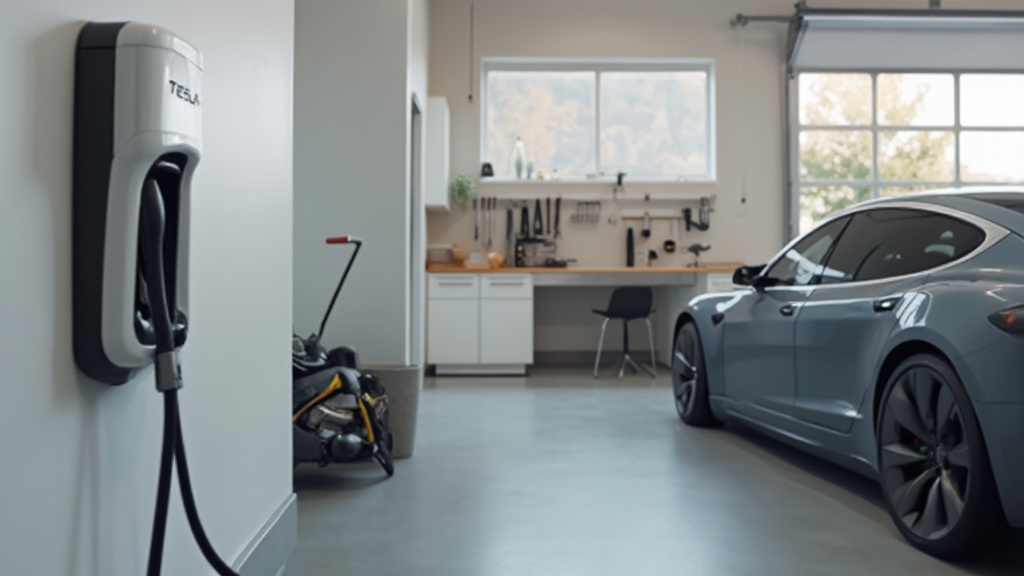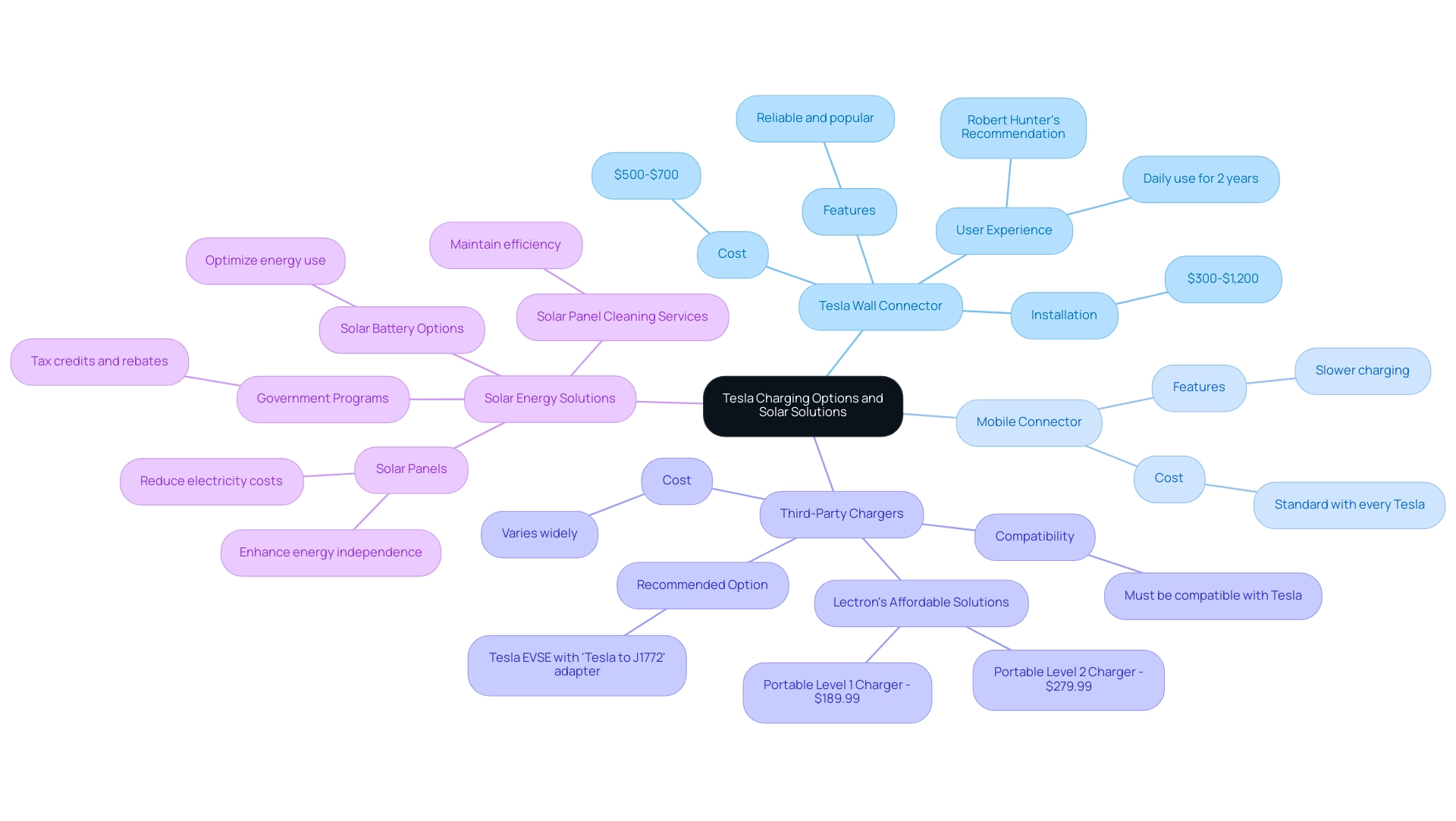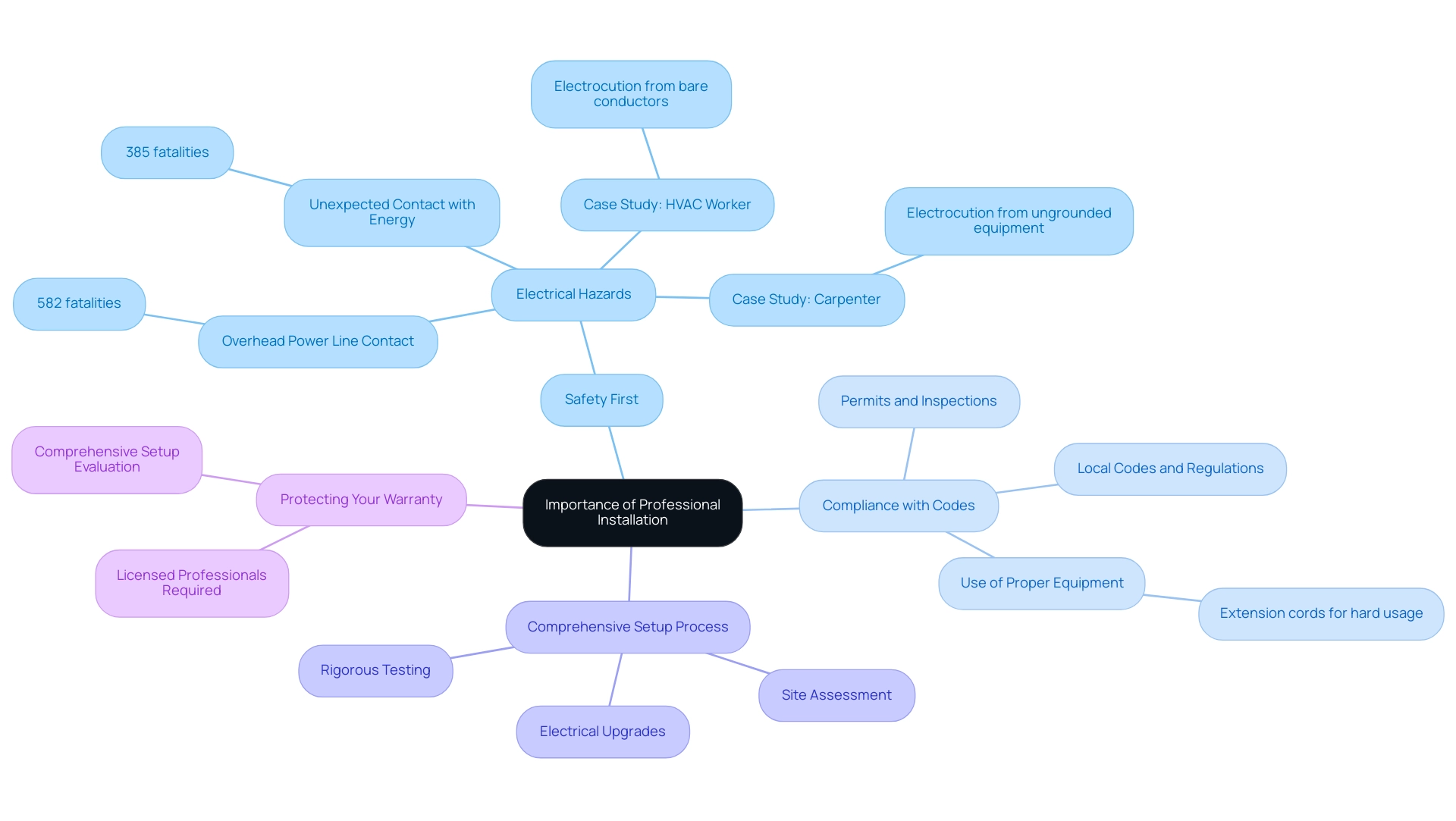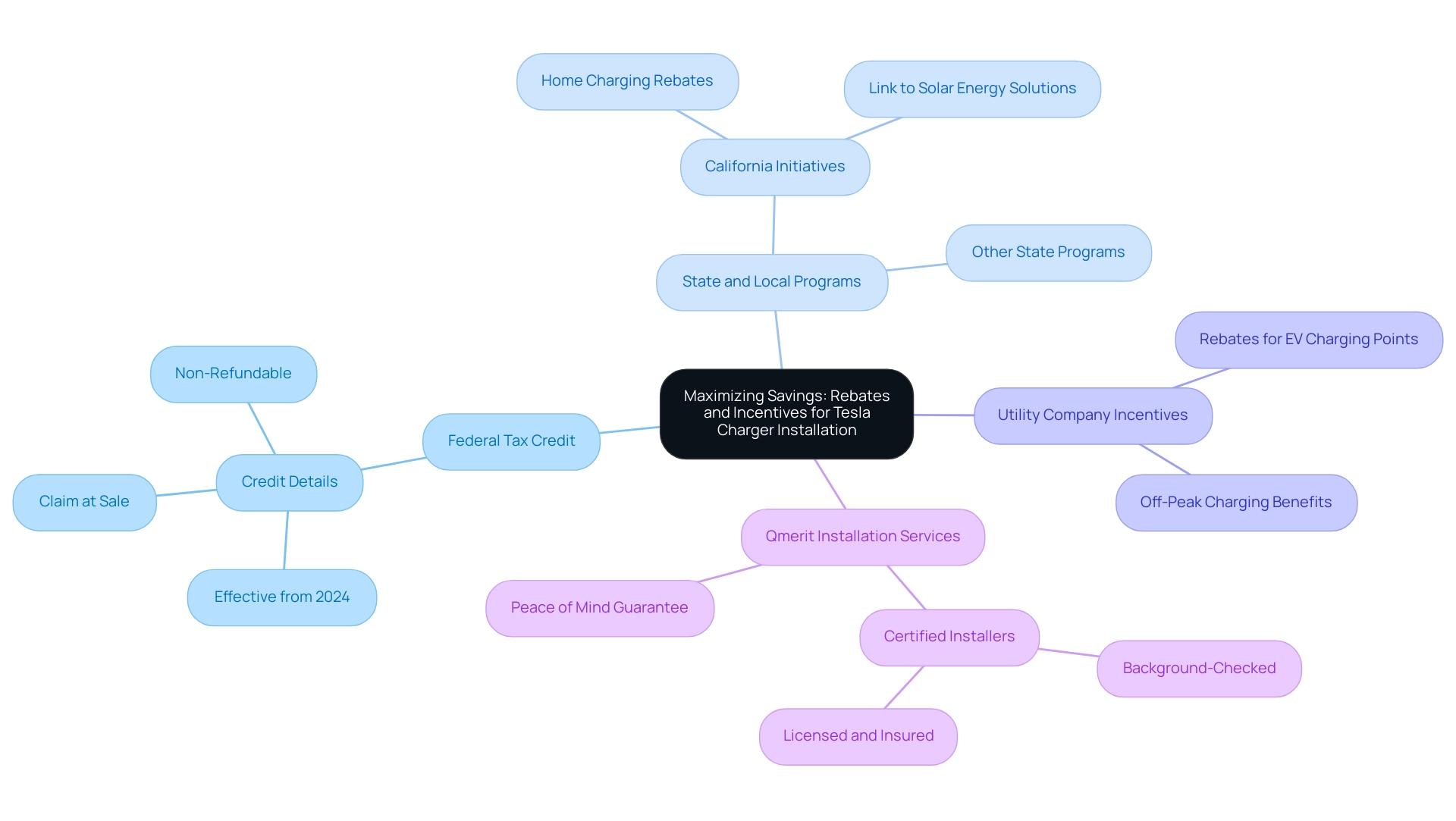Introduction
Installing a Tesla charger at home is more than just a convenience; it’s a strategic move towards sustainability and cost efficiency. As electric vehicles gain traction, understanding the various factors that influence installation costs becomes crucial for homeowners.
From assessing your electrical capacity to navigating permit requirements, each element plays a significant role in shaping the overall expense. Furthermore, exploring different charger types and their associated costs can help in making the right choice tailored to specific needs.
With the added benefits of professional installation and available rebates, this guide will illuminate the path toward a successful and economical charging solution, allowing Tesla owners to maximize their investment while contributing to a greener future.
Understanding the Factors Influencing Tesla Charger Installation Costs
When you’re thinking about installing a Tesla charger at home, a few important factors can really affect the overall cost:
- Electrical Capacity: First things first, your current electrical system needs to handle the additional load of the device. If your setup requires upgrades—like adding a subpanel or even upgrading the main panel—you could be looking at an extra cost of anywhere from $650 to $2,000.
- Distance from Power Source: Another consideration is how far the charger will be from your electrical panel. The longer the run, the more wiring and labor you’ll require, which can significantly increase your setup bill.
- Permit Requirements: Don’t forget about permits! Local regulations might require you to obtain specific permits for the setup, which can add to your total costs. It’s a good idea to check in with your local building department to get the details.
- Labor Costs: Lastly, labor costs can vary widely. In Southern California, for instance, you might find quotes for electrical work around $400. However, as Diana Anderson shared, “Just been quoted $2700 to install a wall charger. The guys seem legit and have great reviews. It’s a bit of a job as the cable needs a lot of routing. Looking at 7 hours of labor and a fair bit of wire etc. It’s a lot but does that sound about right at the high end?” This emphasizes that the overall setup could be quoted at a higher rate if the job involves extensive work—like routing complex cabling—which can take about seven hours.
In addition to these factors, it’s important to consider that residents of apartments or multi-unit dwellings may be able to install EV charging, as laws increasingly require such accommodations. Engaging with property managers about these options could lead to more accessible setup opportunities.
At Powercore Electric Inc., we provide extensive services including solar panel setups and battery backups that can enhance your Tesla charging system. For more information or to schedule a consultation, please contact us at ryan.serrano@powercoreinc.net or call (916) 699-8778. Keeping these factors in mind will help you better estimate how much does it cost to have a Tesla charger installed for your project.
Additionally, with resources like Prairie Electric’s commercial and industrial electricians, you can find experienced professionals to meet your specific station needs.
Exploring Different Types of Tesla Chargers and Their Costs
When it comes to charging your Tesla at home, you have several great options to choose from, each with its own price tag and features, and they play nicely into the broader context of solar energy solutions:
- Tesla Wall Connector: This is the favorite among Tesla owners, typically priced between $500 and $700 for the unit alone. When considering installation costs, which can range from $300 to $1,200, it’s important to ask how much does it cost to have a Tesla charger installed, depending on factors such as your home’s electrical setup and local codes. Many users, like Robert Hunter, love it for its reliability, stating, “I wanted to give a shout to the Eaton outside box matched with the Tesla universal EVSE equipment… Thousands of dollars cheaper than upgrading the other way.”
- Mobile Connector: This handy device comes standard with every Tesla. While it works with a regular outlet, keep in mind that it’s slower and might not be the best fit for daily charging needs.
- Third-Party Chargers: If you’re looking for something budget-friendly, third-party options are available, and prices can vary widely. Just ensure any charger you consider is compatible with Tesla vehicles to avoid any headaches. A recommended inexpensive option is combining a Tesla EVSE with a ‘Tesla to J1772’ adapter, which can provide additional flexibility.
Additionally, consider integrating solar panels into your residence for a more sustainable energy solution. According to the guide on ‘How Solar Panels Work on a House’, these systems can significantly reduce your electricity costs and enhance your energy independence. You might also explore government programs that support solar energy adoption, such as tax credits and rebates, which can help offset installation costs.
Additionally, insights into leading solar panel cleaning services can help maintain efficiency, and discovering the best solar battery options for effective energy storage can optimize your residence’s energy use. With this understanding of your charging options and the broader context of solar energy solutions, you’ll be better equipped to select the right device that fits your needs and budget, while also maximizing the benefits of solar energy.
The Importance of Professional Installation for Safety and Compliance
When considering how much it costs to have a Tesla charger installed at home, enlisting the help of a qualified electrician is not just a wise choice—it’s essential for your safety and peace of mind. Here are some key reasons why professional setup matters:
- Safety First: Electrical hazards are no joke. Incorrect setups can result in serious occurrences such as fires. Professionals at Powercore Electric are trained to follow safety protocols that significantly minimize these risks. For instance, a journeyman HVAC worker tragically lost his life after coming into contact with bare exposed conductors on an extension cord. Furthermore, statistics indicate that primary reasons for electrical fatalities involve overhead power line contact and unforeseen contact with energy, emphasizing the risks linked to improper setups. Such incidents underscore why a trained expert is crucial.
- Compliance with Codes: Every locality has its own codes and regulations concerning electrical setups. A specialist from Powercore Electric will guarantee that your setup meets all required standards, obtaining necessary permits and passing inspections. This adherence is vital, especially when considering recent news that emphasizes the risks associated with non-compliance in electrical work. Moreover, it’s crucial to use extension cords marked for hard or extra-hard usage and equipped with strain relief to ensure safety and compliance.
- Comprehensive Setup Process: Powercore Electric provides a thorough setup procedure that includes a site assessment to determine the best location for your charger, necessary electrical upgrades to accommodate the charger, and rigorous testing to ensure optimal functionality. By putting money into proper setup, including these essential steps, you’re not just ensuring safety; you’re also considering how much it costs to have a Tesla charger installed to protect your investment in your vehicle and charger.
- Protecting Your Warranty: Many manufacturers stipulate that setups be carried out by licensed professionals for warranties to remain valid. By investing in appropriate setup, including a comprehensive site evaluation and any essential electrical enhancements, you’re not just ensuring safety; you’re also protecting your investment in your vehicle and charging unit.
In summary, choosing expert setup means you can relax knowing that your Tesla charging station is arranged properly and securely, keeping both your residence and vehicle safe from potential dangers. The risks of DIY projects are simply not worth it, as demonstrated by the unfortunate case of a young carpenter who was electrocuted while using improperly grounded equipment. This tragic incident serves as a reminder of the importance of prioritizing professional help, a choice that pays off in safety and reliability.
Maximizing Savings: Rebates and Incentives for Tesla Charger Installation
If you’re thinking about setting up a Tesla charging station at your residence, you’ll be glad to hear that there are numerous rebates and incentives accessible to assist in reducing the financial strain:
- Federal Tax Credit: Beginning in 2024, the federal government provides tax credits for electric vehicle charging stations, which can considerably lower your setup expenses. This credit can be claimed at the time of sale at over 9,500 registered dealers, providing immediate savings. Just keep in mind that this credit is non-refundable; it can only lower your federal tax bill, but it’s a great way to save.
- State and Local Programs: California leads the way with various initiatives designed to encourage electric vehicle use, including rebates specifically for home charging installations. Many states have tailored programs to support eco-conscious homeowners, often linking these incentives to solar energy solutions. For instance, if you install solar panels next to your Tesla charging station, you may qualify for additional rebates that enhance your overall savings.
- Utility Company Incentives: Don’t overlook your utility company! Some providers offer rebates or incentives for setting up EV charging points, particularly if you charge during off-peak hours. This can not only save you money upfront but also help keep your electricity bills lower, and by researching how much does it cost to have a Tesla charger installed, you can uncover significant savings, making your investment much more manageable.
Additionally, Qmerit-certified installers are fully background-checked, vetted, licensed, trained, and insured before they even step foot in your home or business. Their services can enhance solar panel setups, maximizing your energy efficiency. With the Qmerit Peace of Mind Guarantee, you can feel confident and secure knowing that the installation process will be handled expertly.
Long-Term Benefits of Installing a Tesla Charger at Home
Installing a Tesla charger in your residence brings a wealth of long-term benefits that can enhance your life as an eco-conscious homeowner:
- Cost Savings: One of the notable benefits of residential power supply is its potential for substantial savings. Typically, powering your vehicle at home is cheaper than using public stations, especially when paired with solar power, but it’s essential to know how much does it cost to have a Tesla charger installed. In fact, the federal tax credit for EV installation can reach up to $1,000, making it an even more appealing option. By leveraging solar energy initiatives, such as California’s Self-Generation Incentive Program (SGIP), you can further decrease your electricity expenses. Comprehending the different pricing models for EV refueling—such as pay-per-use, flat fees, and dynamic pricing—can assist you in managing your expenses efficiently, as these models can significantly influence cost-effectiveness. Monitoring your power usage can reveal additional opportunities to reduce expenses, allowing you to take full advantage of local utility rates and incentives for solar energy, which can vary widely across the US. This awareness of your power usage can lead to better decision-making about when and how to power your vehicle, ultimately enhancing your savings.
- Convenience: Imagine the ease of plugging in your Tesla overnight and waking up to a fully charged vehicle every morning. With a residential charger, particularly when combined with solar energy, you remove the inconvenience of regular stops at public power stations, integrating your power needs effortlessly into your daily schedule. Furthermore, employing roof designs that optimize solar energy can improve the effectiveness of your energy storage system.
- Increased Home Value: As the popularity of electric vehicles continues to rise, having a dedicated charging station can significantly enhance your property’s appeal. Real-world examples show that properties equipped with EV chargers often see an increase in value, making this installation not just a convenience but a smart investment. Moreover, residences with solar panels are increasingly sought after, adding even more value to your property. The long-term expense of powering your vehicle will depend on your personal driving habits and power usage patterns, which can also influence how much does it cost to have a Tesla charger installed, affecting the overall financial advantages of residential energy use. Additionally, keeping your solar panels in good condition with expert cleaning services can guarantee peak performance and durability, further improving your investment.
By considering how much it costs to have a Tesla charger installed as an investment in your residence and lifestyle, you’re preparing to enjoy these advantages for years ahead. The long-term savings, convenience, and potential increase in property value—especially when aligned with solar energy initiatives—make home charging a wise choice for any electric vehicle owner.
Conclusion
Installing a Tesla charger at home is not just about convenience; it’s a strategic investment in sustainability and long-term savings. Understanding the factors influencing installation costs—such as electrical capacity, distance from the power source, permit requirements, and labor costs—empowers homeowners to make informed decisions. Each element plays a crucial role in shaping the overall expense and ensuring a successful installation.
Exploring the different types of chargers available, from the popular Tesla Wall Connector to budget-friendly third-party options, highlights the flexibility in choosing a solution that fits both financial and practical needs. Additionally, the importance of professional installation cannot be overstated; it ensures safety, compliance with local codes, and the protection of warranties, safeguarding both the home and the investment in the vehicle.
Moreover, taking advantage of available rebates and incentives can significantly reduce installation costs, making the transition to home charging even more appealing. With potential savings from federal tax credits, state programs, and utility company incentives, this investment becomes more manageable and attractive.
Ultimately, the benefits of having a Tesla charger at home extend beyond immediate financial savings. The convenience of charging at home, the potential increase in property value, and the positive impact on the environment all contribute to a brighter, more sustainable future. Embracing electric vehicle technology not only enhances personal lifestyles but also fosters a collective movement towards greener living.





